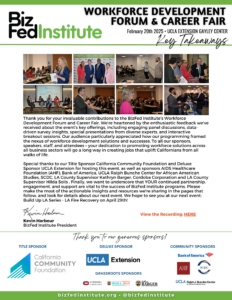More than 150 business, community, and opinon leaders participated in the BizFed Institute’s NextUp Forum: Clean Water for Life and Business at Woodbury University in Burbank on June 4, 2014.  This major half-day educational event brought together top academic, government, industry, and environmental experts to address the opportunities and challenges associated with securing safe, reliable sources of clean water to sustain life and business in Southern California.
As a public service, with grateful support from the Metropolitan Water District of Southern California and the Los Angeles County Department of Public Works, we have produced this electronic document as a one-stop resource highlighting critical intelligence resulting from those proceedings.  By bringing together diverse – and even conflicting – voices, our goal is to move beyond rhetoric and contribute to informed decision making about California’s water resources.
Tracy Rafter
BizFed Founding CEO
|
You can experience the BizFed Institute’s NextUp Forum: Clean Water for Life and Business in its entirety online via YouTube. Or, click any of the following links for the segment you wish to view:
|
|
The Experts: Diverse Points Of View Illuminate Key Issues The following individuals with diverse backgrounds and points of view came together to drive the discussion and share their expertise on how to ensure clean, safe water for California:
|
||||||||||||||||||
|
Hazel – A Tool for Uncovering LA’s Hidden Water Potential
Peter and Hadley Arnold of Woodbury University’s Arid Lands Institute, presented Hazel, a dynamic, integrated planning tool for water-smart urban development in drylands. The Arnolds are national experts in analytic modeling and visualization of stream systems in arid rural environments; the analysis of embedded energy within imported urban water supplies; and the quantification of storm water as groundwater augmentation supply. Click here to download their full presentation. |
||||
|
Special Presentations Highlight California’s Water Challenge
|
||||||
|
Stormwater Funding Options: Providing Sustainable Water Quality Funding in Los Angeles County
Prepared for the California Contract Cities Association and the League of California Cities, Los Angeles Division by NextUp Forum panelist Ken Farfsing, City of Signal Hill, and Richard Watson, Richard Watson & Associates, Inc., this new report:
The recommended actions are voluntary, and the report is not advocating that any city, group of cities, or the County adopt stormwater fees. Click here to download the full report. |
||||
Additional Resources
- How the Drought Affects California’s Energy, Economy, and Emissions Goals, by California Energy Commission
- California Proclamation of Continued State of Emergency (Drought), by Gov. Jerry Brown
- Be Water Wise, by The Metropolitan Water District of Southern California
- Metropolitan Water District’s Annual Progress Report 2014, by The Metropolitan Water District of Southern California
- Summary of State and Federal Water Project Actions in Response to the Drought, by State of California, California Drought
- BizFed Water Bond Priorities, by BizFed Board of Directors
- Poll Finds Little Support for Drought Spending Despite Broad Awareness, by Bettina Boxall, Los Angeles Times
- Water Use Declines 5 Percent Statewide, by State of California, California Drought
- Gov. Jerry Brown Issues New Executive Order on Drought, by Chris Mejerian, Los Angeles Times (with quotes from Steve Fleischli, Director and Senior Attorney, Water Program, Natural Resources Defense Council)
- California’s Drought Ripples Through Businesses, Then to Schools, by NPR
- The Water Revolution California Needs, Los Angeles Times op-ed by Dr. Wade Graham, Pepperdine University and Glen Canyon Institute
- Should People Pay More for Water?, by Aimee Picchi, CBS Moneywatch (article featuring Dr. Wade Graham, Pepperdine University and Glen Canyon Institute)
- Water Revolution, radio interview with Dr. Wade Graham, Pepperdine University and Glen Canyon Institute, by Guy Rathbun, host of IdeaSphere: A Platform for Today’s Voices, Public Radio Exchange (PRX)
- Divining LA: Drylands City Design for the Next 100 Years, by Arid Lands Institute, Woodbury University (presentation shown at event)
- Mapping California’s Water-Energy Nexus, by Arid Lands Institute, Woodbury University
- Design Assistance for Water- and Energy-Wise Communities, by Arid Lands Institute, Woodbury University
- Where Is It? Let’s (Re)Use It by Arid Lands Institute, Woodbury University
- Contemporary Case Studies in Drylands Design, by Arid Lands Institute, Woodbury University
- The Untapped Potential of California’s Water Supply, by Natural Resources Defense Council
- Opinion: Drought-Busting Conservation, Recycling, New Projects, by Steve Fleischli, Director and Senior Attorney, Water Program, Natural Resources Defense Council
- Stormwater Funding Options, by Ken Farfsing, City of Signal Hill, and Richard Watson, Richard Watson & Associates, Inc.
- Stormwater: Asset Not Liability, by Dr. Suzanne Dallman and Dr. Thomas Piechota; edited by Los Angeles & San Gabriel Rivers Watershed Council
- LA County Liable for Storm-Water Pollution, Court Rules, by Abby Sewell, Los Angeles Times, featuring comments by Mark Pestrella, Assistant Director, Los Angeles County Department of Public Works, and  Steve Fleischli, Director and Senior Attorney, Water Program, Natural Resources Defense Council
- A Vision for 2025: Sustainable California, by Mike Antos, Programs Director, Council for Watershed Health
- Water in an Age of Scarcity: How Do We Ensure Our Water Supply?, WatershedWise Quarterly Magazine, Spring 2014, by Council for Watershed Health
- Urban Stormwater Program, by Council for Watershed Health
- Green Infrastructure Opportunities and Barriers in the Greater Los Angeles Region, by U.S. Environmental Protection Agency (EPA) and Council for Watershed Health
- LA River Could Go Lower in Water Purification Plan, by Mike Reicher, Los Angeles Daily News, featuring comments by Mike Antos, Programs Director, Council for Watershed Health, and Jim McDaniel, Senior Assistant General Manager – Water System, City of Los Angeles Department of Water and Power
- Local Agencies Win Big in Latest Surge of State Funding, by Mark Pestrella, Assistant Director, Los Angeles County Department of Public Works
- Colorado River Drought Forces a Painful Reckoning for States, by Michael Wines, New York Times















